Graphene, the extraordinary form of carbon that consists of a single layer of carbon atoms, has produced another in a long list of experimental surprises. In the current issue of the journal Science, a multi-institutional team of researchers headed by Michael Crommie, a faculty senior scientist in the Materials Sciences Division at the U.S. Department of Energy's Lawrence Berkeley National Laboratory and a professor of physics at the University of California at Berkeley, reports the creation of pseudo-magnetic fields far stronger than the strongest magnetic fields ever sustained in a laboratory – just by putting the right kind of strain onto a patch of graphene.
"We have shown experimentally that when graphene is stretched to form nanobubbles on a platinum substrate, electrons behave as if they were subject to magnetic fields in excess of 300 tesla, even though no magnetic field has actually been applied," says Crommie. "This is a completely new physical effect that has no counterpart in any other condensed matter system."
Viewed quantum mechanically, however, cyclotron orbits become quantized and exhibit discrete energy levels. Called Landau levels, these correspond to energies where constructive interference occurs in an orbiting electron's quantum wave function. The number of electrons occupying each Landau level depends on the strength of the field – the stronger the field, the more energy spacing between Landau levels, and the denser the electron states become at each level – which is a key feature of the predicted pseudo-magnetic fields in graphene.
Describing their experimental discovery, Crommie says, "We had the benefit of a remarkable stroke of serendipity."
Crommie's research group had been using a scanning tunneling microscope to study graphene monolayers grown on a platinum substrate. A scanning tunneling microscope works by using a sharp needle probe that skims along the surface of a material to measure minute changes in electrical current, revealing the density of electron states at each point in the scan while building an image of the surface.
Crommie was meeting with a visiting theorist from Boston University, Antonio Castro Neto, about a completely different topic when a group member came into his office with the latest data.
"It showed nanobubbles, little pyramid-like protrusions, in a patch of graphene on the platinum surface," Crommie says, "and associated with the graphene nanobubbles there were distinct peaks in the density of electron states."
Crommie says his visitor, Castro Neto, took one look and said, "That looks like the Landau levels predicted for strained graphene."
Sure enough, close examination of the triangular bubbles revealed that their chicken-wire lattice had been stretched precisely along the three axes needed to induce the strain orientation that Guinea and his coworkers had predicted would give rise to pseudo-magnetic fields. The greater the curvature of the bubbles, the greater the strain, and the greater the strength of the pseudo-magnetic field. The increased density of electron states revealed by scanning tunneling spectroscopy corresponded to Landau levels, in some cases indicating giant pseudo-magnetic fields of 300 tesla or more.
"Getting the right strain resulted from a combination of factors," Crommie says. "To grow graphene on the platinum we had exposed the platinum to ethylene" – a simple compound of carbon and hydrogen – "and at high temperature the carbon atoms formed a sheet of graphene whose orientation was determined by the platinum's lattice structure."
To get the highest resolution from the scanning tunneling microscope, the system was then cooled to a few degrees above absolute zero. Both the graphene and the platinum contracted – but the platinum shrank more, with the result that excess graphene pushed up into bubbles, measuring four to 10 nanometers (billionths of a meter) across and from a third to more than two nanometers high.
To confirm that the experimental observations were consistent with theoretical predictions, Castro Neto worked with Guinea to model a nanobubble typical of those found by the Crommie group. The resulting theoretical picture was a near-match to what the experimenters had observed: a strain-induced pseudo-magnetic field some 200 to 400 tesla strong in the regions of greatest strain, for nanobubbles of the correct size.
"Controlling where electrons live and how they move is an essential feature of all electronic devices," says Crommie. "New types of control allow us to create new devices, and so our demonstration of strain engineering in graphene provides an entirely new way for mechanically controlling electronic structure in graphene. The effect is so strong that we could do it at room temperature."
The opportunities for basic science with strain engineering are also huge. For example, in strong pseudo-magnetic fields electrons orbit in tight circles that bump up against one another, potentially leading to novel electron-electron interactions. Says Crommie, "this is the kind of physics that physicists love to explore." ###
"Strain-induced pseudo-magnetic fields greater than 300 tesla in graphene nanobubbles," by Niv Levy, Sarah Burke, Kacey Meaker, Melissa Panlasigui, Alex Zettl, Francisco Guinea, Antonio Castro Neto, and Michael Crommie, appears in the July 30 issue of Science. The work was supported by the Department of Energy's Office of Science and by the Office of Naval Research.
Lawrence Berkeley National Laboratory provides solutions to the world's most urgent scientific challenges including clean energy, climate change, human health, novel materials, and a better understanding of matter and force in the universe. It is a world leader in improving our lives and knowledge of the world around us through innovative science, advanced computing, and technology that makes a difference. Berkeley Lab is a U.S. Department of Energy (DOE) national laboratory managed by the University of California for the DOE Office of Science. Visit our website.
Contact: Paul Preuss paul_preuss@lbl.gov 510-486-6249 DOE/Lawrence Berkeley National Laboratory
















No comments:
Post a Comment